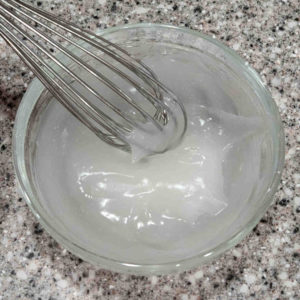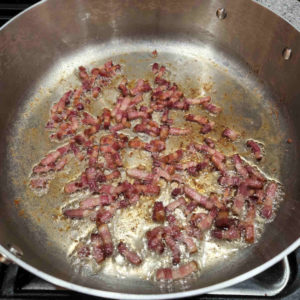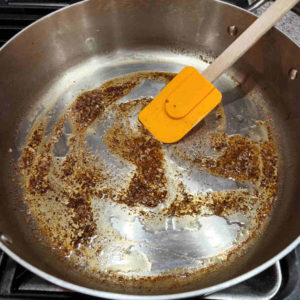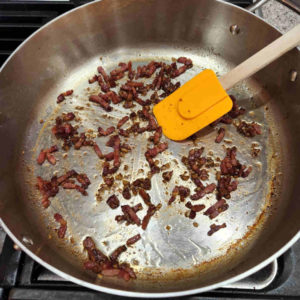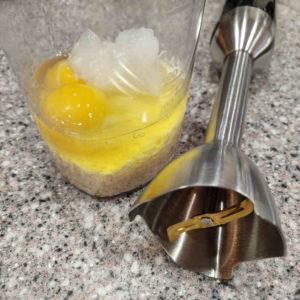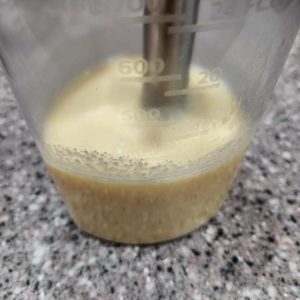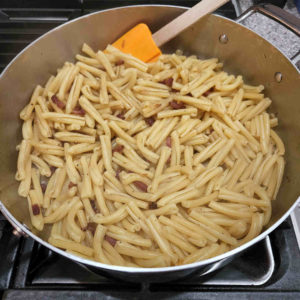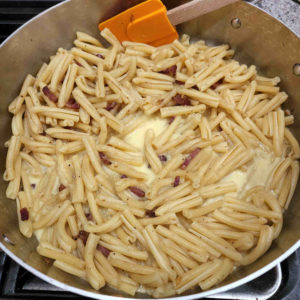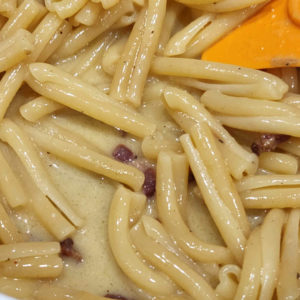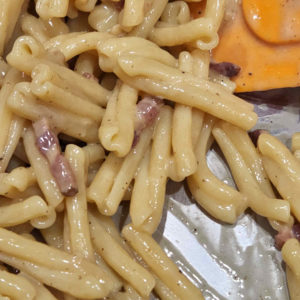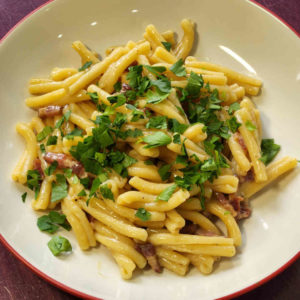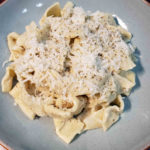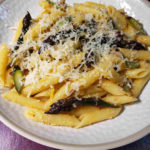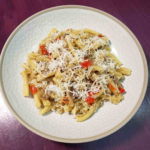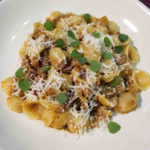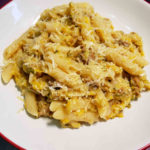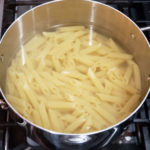Introduction
Over the years, I’ve made Pasta Carbonara many times, with inconsistent results. The biggest problem was how the eggs tended to form tiny curds as they cooked, instead of thickening into a creamy sauce. I had similar issues with Cacio e Pepe, where the cheese tended to either not melt into a sauce or it turned into a stringy mess which stuck to the pan as much as it stuck to the pasta.
That changed when I came across this video by Roman chef Luciano Monosilio. Luciano speaks in Italian, but there are English subtitles. Luciano demonstrates three methods of cooking Cacio e Pepe with the middle method being foolproof (infallibile). The infallibile method was a game changer for me. The first method Luciano demonstrated was traditional. Of course, he was successful with that method but he explained that a precise temperature control was absolutely required. Too cool and the cheese doesn’t melt and the sauce doesn’t get creamy. Too hot and the cheese turns into a stringy mess. To get what you are looking for, you have to keep it in the Goldilocks zone. When you need it to be right and be right fast, the infallibile method is the way to go! Luciano actually uses it in his restaurant. The secret is to incorporate a cornstarch gel into the sauce. The cornstarch acts as an emulsifier allowing the cheese and the pasta water to form a creamy sauce under higher heat without the cheese separating into a stringy mess. My first attempt with Cacio e Pepe using this trick was a complete success. Then I remembered reading about using corn starch slurry to make creamier scrambled eggs, so I thought the same idea might work for Pasta Carbonara. I tried it, and, again, immediate success on a dish with which I was historically inconsistent. (In case you are wondering, the third method that Luciano demonstrated was a gourmet version of the dish with high end ingredients and modern techniques.)
The Dish
Carbonara is one of the most debated and beloved dishes in the Roman pasta pantheon. While there is little agreement as to the dish’s origins or its ingredients, it does get its own holiday. The main ingredients:
- Eggs: Eggs cooked by the residual heat of pasta just pulled from boiling water is the backbone of Carbonara’s rich, silky sauce. But, do you use whole eggs, just the yolks, or a combination? There’s no doubt that using just yolks or adding extra yolks increases the richness of the sauce. But, I hate trying to figure out what to do with the leftover egg whites. I use whole eggs.
- Cured Pork: Most traditionally, in Rome, this pork is going to be guanciale, cured pork jowl. In Italy, the most common substitute is pancetta, cured pork belly. In the US, both guanciale and pancetta can be found in higher-end groceries and specialty markets. But, in the US, the most common cured pork is bacon. The main difference between bacon and pancetta is that bacon is smoked. The smoke flavor will add a distinctive note to a finished plate of carbonara. Is that distinctive note desirable? That’s really up to you.
- Cheese: The third vital component to carbonara is an aged, hard, grating cheese. In Rome, expect Pecorino Romano. Many find Parmigiano Reggiano to be an acceptable or even preferrable substitute. Marcella Hazan specifies a combination of the two. I’ve used, and enjoy both, but I have a soft spot for Calvander, a cheese made in the style of aged Asiago by Chapel Hill Creamery. Italian cuisine is based on using the best ingredients that the locale provides, and Chapel Hill is my home.
- The nuances: From here, the recipes vary. This dish needs no olive oil. Plenty of fat is rendered from the pork. Generally too much. After rendering the fat from the pork, I remove the pork and drain most of the fat from the pan (saved for future use!). I leave a generous tablespoon in the pan. I then bloom a generous amount of black pepper and some minced garlic in that pork fat. I then deglaze the pan with a glug of white wine.
- The Secret Ingredient: As mentioned in the intro, a gel of cornstarch is a secret ingredient to minimize egg curdling and cheese stringing. The gel only takes 30 seconds in the microwave. Whisk up a slurry, put in the microwave for 15 seconds, re-whisk, put back in the microwave for another 15 seconds, and then give it a final whisk. Note, the creamier scrambled eggs hack uses a raw slurry, not a gel. I tried the raw slurry, but the results are better with the gel. I use an immersion blender to puree the cornstarch gel, eggs, cheese and some pasta water into a runny homogenous blend. This goes into the pan with the pasta and everything else. With some stirring over medium-low to medium heat, it thickens up into the desired rich and creamy sauce clinging to the sides of the pasta.
- The Pasta: Spaghetti or other long noodles are the most traditional. But there are those who favor short noodles. I’m among them, unless I’m using fresh pasta. If you go the route of short, dried pasta, I encourage you to give this method a try. Regardless, you need the pasta water to be properly seasoned with salt, as some of that pasta water is used to finish the sauce. You want the water salted like soup (delicious), not salted like the sea (not delicious).
- Salt: Salt is a bit tricky. Between the salted pasta water, the cured pork, and the aged cheese, there is likely plenty of salt without the need to add any more, but it’s tragic if this dish is served under seasoned. Taste a single noodle before serving. If it needs salt, add it now and stir well to combine.
- Garnish: Chopped fresh parsley is the preferred garnish. Chopped fresh chives are an OK substitute. Extra grated cheese is always nice. No garnish, no problem – the dish stands up well on its own.
Don’t Forget Your Veggies
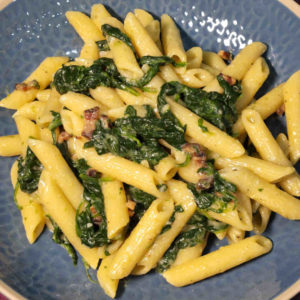
Pasta Carbonara is such a delicious dish, you should be hesitant to tamper with it. But if you blanch up some baby spinach or other tender green in the same water that you cook the pasta, you can stir that in, and it tastes really good!
Photo Walk Through of Recipe
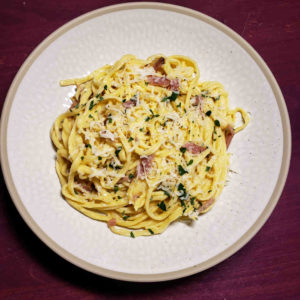
Infallibile Pasta Carbonara
Ingredients
- 50 grams water a generous 3 tbsp
- 5 grams cornstarch about 2 tsp
- 2 oz grated Pecorino Romano see notes
- 6 oz guanciale see notes
- 2 large eggs
- 2-3 cloves garlic minced
- freshly ground black pepper
- 4 tbsp fresh parsley chopped
- 1 lb dry pasta
- salt
- 2 fl. oz reserved pasta cooking water
Instructions
Prepare the cornstarch gel
- Place the 50 grams of water and 5 grams of cornstarch in a microwavable bowl and whisk into a slurry.
- Place in the microwave for 15 seconds. The corn starch should have started to thicken, but also has drifted toward the bottom of the bowl. Re-whisk the solution.
- Return to the microwave for another 15 seconds and re-whisk. At this point the gel should be stable. If not one more round in the microwave and one more whisk should do it.
- Allow the cornstarch gel to cool
Prepare the sauce ingredients
- Select a container that works well with an immersion blender. Most immersion blenders come with a mixing cup, and wide mouthed mason jars generally work well.
- Add the eggs, grated cheese, and the cooled cornstarch gel to the container.
Prepare the pan ingredients
- Whichever cured pork option you chose, chop the pork into small pieces and cook over medium-low heat in a large skillet so it renders the fat and gets a little crispy.
- Remove the cooked pork to a bowl and set aside. Drain all but about a tablespoon of the pork fat from the pan.
- Add the minced garlic and a generous amount of freshly ground black pepper to the pan. Stir and let them sizzle a couple minutes in the pork fat.
- Deglaze the pan with the white wine. Return the cooked pork to the pan and stir. Turn off the heat for now.
Prepare the pasta
- Prepare the pasta according to package directions. Alternately use the directions available at https://thought4food.life/kenjis-new-way-to-cook-pasta/. The pasta water should be well seasoned with salt. Think salted like soup (delicious), not salted like the ocean (not delicious).
- Reserve a cup of the pasta cooking water at the end of the cooking process.
Blend the sauce and finish the pasta
- Add twoounces of the pasta cooking water to sauce ingredients and use an immersion blender to puree everything into a homogenous sauce.
- Add the still hot, drained pasta and the pureed sauce to the pan with the pork, garlic and black pepper. Return the heat to medium-low, and stir with a silicon spatula. Continue heating and stiring until the sauce has obtained the desired creamy texture and clings nicely to the pasta.
- Plate the pasta and garnish with chopped parsley
Notes
- Guanciale (cured pork jowl) is the traditional pork used in Carbonara. Pancetta (cured pork belly) is the closest substitute. Bacon is another possible substitute. Like pancetta, bacon is also cured pork belly, but bacon is smoked. Whether you appreciate the smoked nuance or not is up to you.
- Pecorino Romano is the traditional cheese for Carbonara. But some people prefer Parmigiano Reggiano or a blend of the two cheeses. Other flavorful, aged grating cheeses will also work. The choice is really up to you.
- 2 ounces of hard grating cheese, by weight, is about 2/3 cup in volume.

